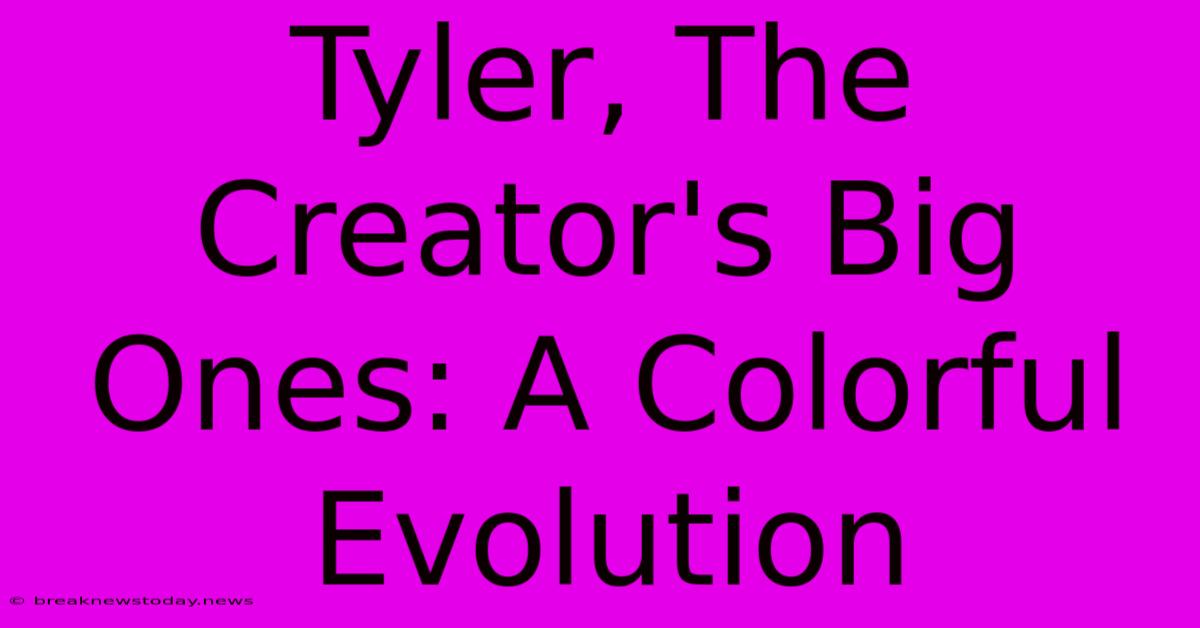Tyler, The Creator's Big Ones: A Colorful Evolution

Discover more detailed and exciting information on our website. Click the link below to start your adventure: Visit Best Website naughtynakes.com. Don't miss out!
Table of Contents
Tyler, The Creator's Big Ones: A Colorful Evolution
Tyler, The Creator. The name alone conjures up images of vibrant, chaotic energy, a tapestry woven from controversial lyrics, genre-bending music, and a visually stunning aesthetic. From his early days as a controversial figure in the hip-hop scene to his current status as a cultural icon, Tyler's journey has been one of constant evolution, marked by a captivating interplay of boldness, vulnerability, and a constant push for artistic boundaries.
This journey, much like the vibrant colors that define his music videos and stage presence, is a story of self-discovery, growth, and the persistent quest for self-expression. Let's dive into the evolution of Tyler, The Creator, from the controversial beginnings of Bastard to the soulful maturity of Call Me If You Get Lost.
The Early Years: Rebellion and Controversy
The arrival of Bastard in 2009 shook the hip-hop landscape. Filled with raw energy and unapologetic lyrics that tackled themes of rebellion, sexuality, and social commentary, it garnered both acclaim and controversy. Tyler's early work was characterized by its abrasive nature, showcasing a raw talent that refused to be confined by genre conventions. He was unafraid to push boundaries, challenging the status quo and igniting conversations about the evolving landscape of hip-hop.
The subsequent releases, Goblin and Wolf, further cemented Tyler's status as a controversial figure. Both albums continued to explore themes of mental health, societal anxieties, and the struggle for self-acceptance. While the lyrical content often pushed the boundaries of what was deemed acceptable, it also resonated with a generation grappling with similar internal struggles.
A Shift Towards Self-Reflection and Vulnerability
With Cherry Bomb (2015), Tyler took a significant step towards self-reflection. The album marked a departure from the abrasive tone of his earlier works, delving deeper into themes of introspection, love, and personal growth. His lyrics became more nuanced, showcasing a willingness to embrace vulnerability and explore the complexities of his own emotions.
This evolution culminated in the release of Flower Boy (2017), an album that garnered widespread critical acclaim. It marked a watershed moment in Tyler's career, showcasing his growth as an artist and his increasing comfort in vulnerability. The album was a love letter to self-discovery, exploring themes of identity, sexuality, and the complexities of human connection.
The Tapestry of Igor and Call Me If You Get Lost
Tyler continued to push creative boundaries with the release of Igor (2019). This experimental masterpiece showcased his musical versatility and storytelling prowess. The album was a journey through heartbreak and reconciliation, weaving together a narrative of love lost and found through a kaleidoscope of sounds and emotions.
His latest album, Call Me If You Get Lost, (2021) sees Tyler embrace his newfound confidence and playfulness. He crafts a more accessible and commercially successful album while still retaining the raw energy that defined his early work. It’s a celebration of life, filled with luxurious production and vibrant sonic landscapes.
Tyler, The Creator: A Legacy of Color and Evolution
Tyler, The Creator's journey is a testament to the power of constant reinvention and self-expression. From the raw energy of his early works to the introspective maturity of his later albums, his music has consistently challenged societal norms and captivated audiences worldwide. His legacy lies not just in the music he creates but in the vibrant tapestry of colors that define his artistry, reminding us that evolution is an integral part of the creative process.
Keywords: Tyler, The Creator, music, hip-hop, evolution, album, Bastard, Goblin, Wolf, Cherry Bomb, Flower Boy, Igor, Call Me If You Get Lost, self-discovery, vulnerability, controversy, artist, creativity, legacy.

Thank you for visiting our website wich cover about Tyler, The Creator's Big Ones: A Colorful Evolution . We hope the information provided has been useful to you. Feel free to contact us if you have any questions or need further assistance. See you next time and dont miss to bookmark.
Featured Posts
-
Liverpool Earns Point At Arsenal After Two Comebacks
Oct 28, 2024
-
Tony Hinchcliffe Responds To Puerto Rico Criticism
Oct 28, 2024
-
Dangerous Chemicals Found In Chinese Shine Muscat Grapes
Oct 28, 2024
-
Cricket Sixes And Valhalla Team Up For Blockchain
Oct 28, 2024
-
Kto Wygra Parma Empoli Analiza Meczowa 27 10
Oct 28, 2024
